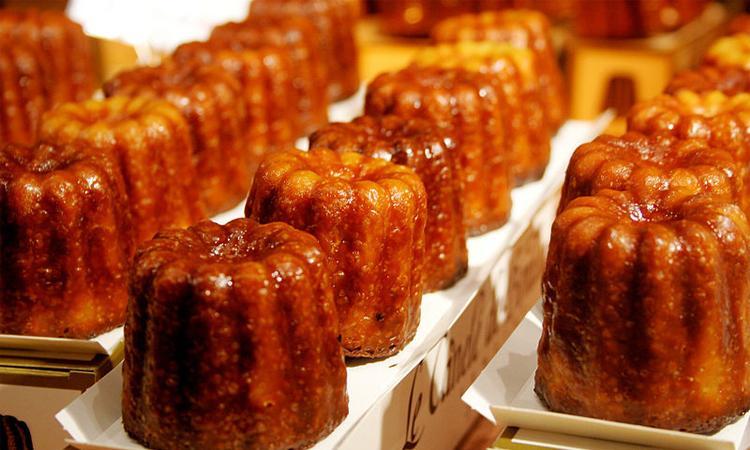 est recouvert d'une épaisse croûte caramélisée et a une jolie forme de cylindre strié. On ne connait pas sûrement les origines mais son développement provient de l'activité portuaire importante que connut la ville de Bordeaux. Arrivaient à Bordeaux de nombreux navires chargés de vanille et de sucre de canne. Par ailleurs, à cette époque, les viticulteurs employaient le blanc d'oeuf pour "coller" le vin, c'est à dire le clarifier (enlever les impuretés en les faisant descendre au fond du tonneau). Que faire des jaunes ? La solution était trouvée, ils furent donnés aux pâtissiers, les canauliers, qui confectionnèrent ces merveilles. C'est une véritable institution en Aquitaine, on compte plus de 1000 artisans le fabriquant. Si vous vous promenez à Bordaux, passez chez Baillardran ou à la Toque Cuivrée mais n'hésitez pas à aller sur un marché, parfois on y trouve de bonnes surprises...
est recouvert d'une épaisse croûte caramélisée et a une jolie forme de cylindre strié. On ne connait pas sûrement les origines mais son développement provient de l'activité portuaire importante que connut la ville de Bordeaux. Arrivaient à Bordeaux de nombreux navires chargés de vanille et de sucre de canne. Par ailleurs, à cette époque, les viticulteurs employaient le blanc d'oeuf pour "coller" le vin, c'est à dire le clarifier (enlever les impuretés en les faisant descendre au fond du tonneau). Que faire des jaunes ? La solution était trouvée, ils furent donnés aux pâtissiers, les canauliers, qui confectionnèrent ces merveilles. C'est une véritable institution en Aquitaine, on compte plus de 1000 artisans le fabriquant. Si vous vous promenez à Bordaux, passez chez Baillardran ou à la Toque Cuivrée mais n'hésitez pas à aller sur un marché, parfois on y trouve de bonnes surprises...
 Is covered with a thick caramelized crust and has an attractive shape of streaked cylinder. We do not know certainly its origins but its development comes from the important harbour activity which knew the city of Bordeaux. Numerous ships loaded with vanilla and cane sugar arrived to Bordeaux. Besides, at that time, the wine growers used the egg white "to stick" the wine, that is to clarify it (remove the impurities by making them fall down at the bottom of the barrel). What's to be done with the egg yellow? The solution was found, they were given to the pastry cooks, the canauliers, which made these marvels. It is a real institution in Aquitaine, we count more than 1000 craftsmen making it. If you walk to Bordaux, pass at Baillardran or at the Toque Cuivrée but do not hesitate to visit a market, sometimes we find some realy good surprises there...
Is covered with a thick caramelized crust and has an attractive shape of streaked cylinder. We do not know certainly its origins but its development comes from the important harbour activity which knew the city of Bordeaux. Numerous ships loaded with vanilla and cane sugar arrived to Bordeaux. Besides, at that time, the wine growers used the egg white "to stick" the wine, that is to clarify it (remove the impurities by making them fall down at the bottom of the barrel). What's to be done with the egg yellow? The solution was found, they were given to the pastry cooks, the canauliers, which made these marvels. It is a real institution in Aquitaine, we count more than 1000 craftsmen making it. If you walk to Bordaux, pass at Baillardran or at the Toque Cuivrée but do not hesitate to visit a market, sometimes we find some realy good surprises there...






